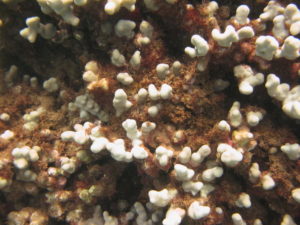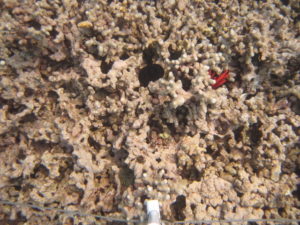Signs of Reef Recovery Emerging in North Kāʻanapali
Hopeful signs of reef recovery emerging in North Kāʻanapali
(Public invited to learn more at the 2017 Ridge to Reef Rendezvous on Oct. 28, details below)
By: Russell Sparks, Hawaiʻi Department of Land and Natural Resources, Division of Aquatic Resources

A comparison of the reef substrate showing mats of seaweed and turf algae prior to the KHFMA going into effect (TOP PHOTO), and then the open space and coverings of crustose coralline algae 7 years following the area’s designation (BOTTOM PHOTO). Credit: Hawaiʻi Department of Land and Natural Resources, Division of Aquatic Resources
In 2009, a novel form of fisheries management officially went into effect along an approximately two-mile section of the north Ka‘anapali coastline in West Maui. This area – the Kahekili Herbivore Fisheries Management Area – is the first place in Hawaiʻi where fish stocks are managed with the specific goal of improving the health and resiliency of the coral reef itself – not just the fish.
Leading up to the establishment of the KHFMA, state monitoring results showed that coral cover in the reefs along this section of coastline had declined dramatically and that reefs were periodically overgrown by blooms of seaweed.
The condition of the reef was particularly concerning in 2005 and 2006, when dense summer blooms of the alien seaweed Acanthophora spicifera appeared to be accelerating the ongoing declines in coral cover. Survey data from this time showed that the herbivore fish biomass – which takes into account the total number of fishes and their sizes –within the area was low compared to similar habitats around other parts of Maui, particularly compared to marine reserves where fishes are protected from harvest.

A comparison of the reef substrate showing mats of seaweed and turf algae prior to the KHFMA going into effect (TOP PHOTO), and then the open space and coverings of crustose coralline algae 7 years following the area’s designation (BOTTOM PHOTO). Credit: Hawaiʻi Department of Land and Natural Resources, Division of Aquatic Resources
Since January of 2008, the State Division of Aquatic Resources has partnered with, first, the University of Hawaiʻi, and then NOAA Pacific Islands Fisheries Science Center to conduct comprehensive monitoring of the coral reef areas within what is now the KHFMA. Those surveys involve detailed fish and habitat surveys conducted twice per year within the KHFMA, and in some nearby areas just outside of the reserve boundaries.
Results of these assessments are very promising.
At the end of 2016, seven years following the management area designation, there were clear signs that important grazing fishes are increasing in size and numbers. Parrotfishes have shown a nearly 170% increase in biomass (total weight of parrotfish per square meter of habitat), and surgeonfishes have experienced a more moderate 24% increase in biomass.
More importantly, however the substrate, or surface of the reef base, appears to be changing in some critical ways. The mats of seaweed and the covering of algal turf (fuzzy covering of small filamentous seaweeds) that once dominated the area have been replaced by large areas of crustose coralline algae (the purple and pink crusts of calcified seaweed).
Corals tend to thrive in areas of high crustose algae. Juvenile corals prefer to settle on reefs with high crustose algal cover, and corals also tend to grow faster when they are not competing for space with thick algal turfs and seaweeds. Living coral cover as been slower to respond.
The good news, however, is that the earlier declines in coral cover have stopped, and there are signs of recovery. Corals grow relatively slowly, so recovery takes time, but the positive impacts of herbivore protection at the KHFMA have greatly improved conditions for local corals to thrive.
Maui residents and visitors can learn more about the KHFMA at the annual Ridge to Reef Rendezvous at Kahekili Beach Park (Old Airport Beach) in North Ka‘anapali on Oct. 28, from 9 a.m. to noon.
The free family event will feature food, fun, music and prizes. There will be a keiki fishing tournament, scavenger hunt for all ages, and a haunted reef to explore. Participants can learn about the important management area and other actions being taken in the water and on land to help protect the coral reefs of West Maui.
*The Keiki fishing tournament will begin at 8 a.m.
For more information, click here or call (808) 283-1631.










